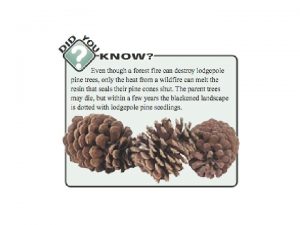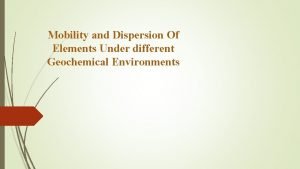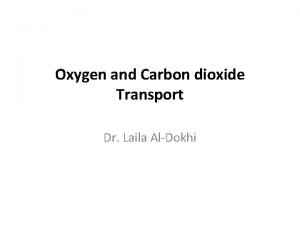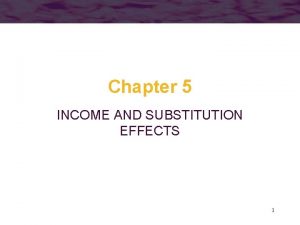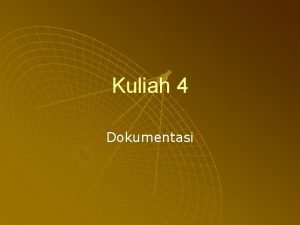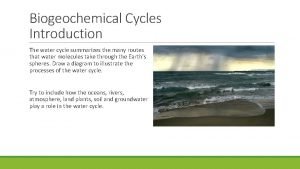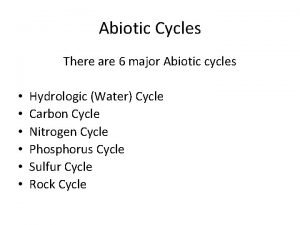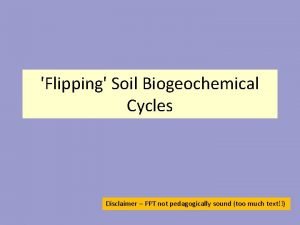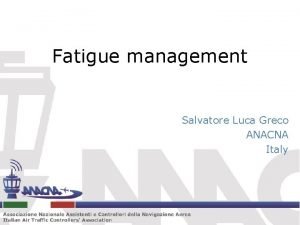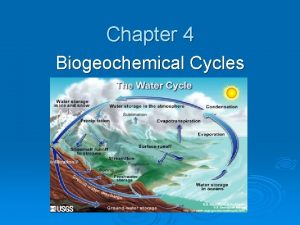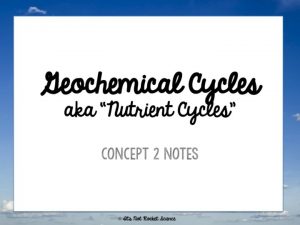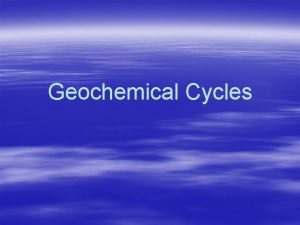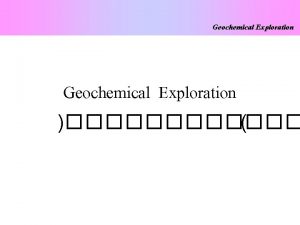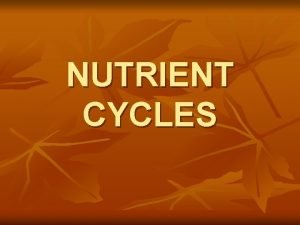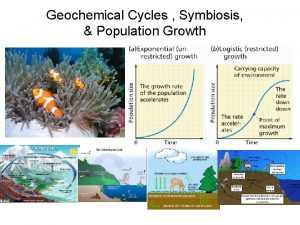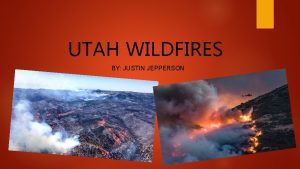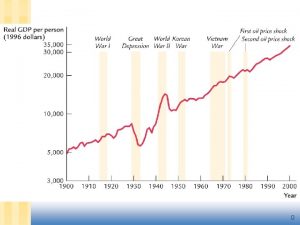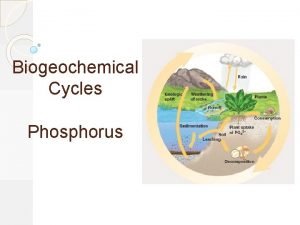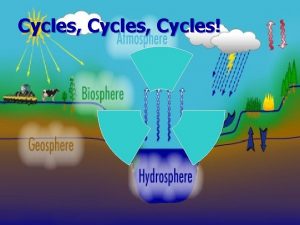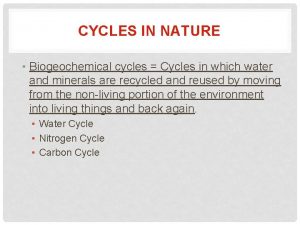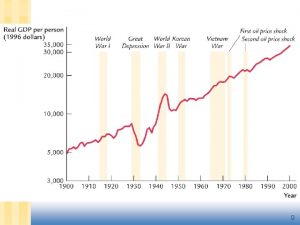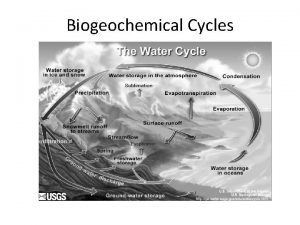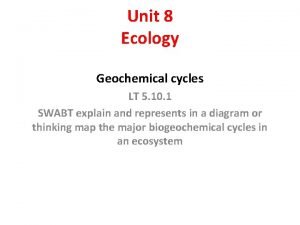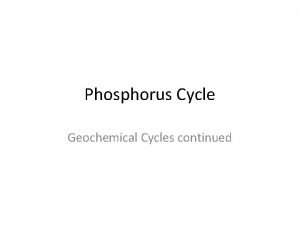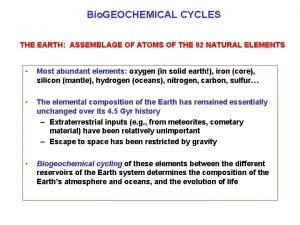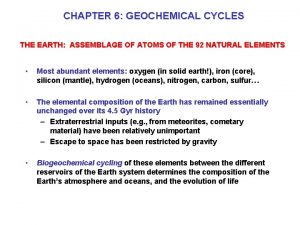Effect of Wildfires on ALL Geochemical Cycles Summary
































- Slides: 32


Effect of Wildfires on ALL Geochemical Cycles: Summary Water water vapour is produced in a combustion reaction: C 6 H 12 O 6(s) + 6 O 2(g) 6 CO 2(g)+ 6 H 2 O(g) eas r c in e ea decr e less tree roots & vegetation means less retention of water in the soil s Carbon Oxygen heat breaks nitrogen compounds down into nitrates & ammonia; same effect as nitrogen fixation dramatic increase in nitrogen levels in soil: more viable for bacteria combustion produces CO 2 (carbon source): C 6 H 12 O 6(s) + 6 O 2(g) 6 CO 2(g) + 6 H 2 O(g) loss of green plants to undergo photosynthesis (loss of a carbon sink) Nitrogen loss of plants to undergo photosynthesis (loss of an oxygen source) AND combustion reactions uses O 2 from the atmosphere C 6 H 12 O 6(s) + 6 O 2(g) 6 CO 2(g) + 6 H 2 O(g)

The Recycling of Matter: Water and Biogeochemical Cycles Practice Questions Answer Key ( / 18)

Question 1: Use the information below to answer question 1 Prescribed burning is a practice in which forestry personnel deliberately set small, controlled fires under ideal weather conditions — low winds and reasonably high moisture content. This strategy attempts to mimic the historical pattern of more frequent, low-intensity burns that are an integral part of the forest ecology. 1. Explain how this practice may actually enhance public safety and ensure the long-term health of the forest. (2 marks) ü A prescribed burn mimics a natural wildfire, but b/c they occur MORE frequently, they burn with LESS intensity, than be SMALLER. ü Another advantage of is that it reduces the accumulation of “fuel” , (old dry branches and pine needles), so that a large catastrophic fire is less likely. ü AND helps maintain the long-term health and diversity of the forest habitat, since fires ARE needed for conifers to reproduce.

Question 2: 1. AA 2. For organisms that live in the forest floor’s soil, identify at least two abiotic factors significantly affected by wildfires. (2 marks) ü Wildfires remove the surface vegetation ü Abiotic factor affected: shade ü Wildfires are an exothermic combustion reaction ü Abiotic factor affected: temperature (experienced by organisms living within the soil). ü Wildfires are an exothermic combustion reaction, which break down nitrogen molecules ü Abiotic factor affected: nitrogen (availability for plants in ashy soil left after fire is extinguished). ü Wildfires REMOVE atmospheric oxygen and ADDS carbon dioxide. ü Abiotic factor affected: O 2 and CO 2 levels ü Wildfires REMOVE water from the ecosystem (b/c vegetation is removed). ü Abiotic factor affected: water levels

Question 3: 1. 2. AA Mmf 3. What is a biogeochemical cycle? (1 mark) ü A series of reactions that move elements and compounds between the living and non-living components of an ecosystem. ü Ex. carbon cycle, oxygen cycle, and the nitrogen cycle

Question 4: 4. Water is often applied to lawns and gardens to keep plants 1. 2. 3. AA A Nnnb healthy and green. a) Use your knowledge of the water cycle to explain why it is more effective to water lawns in the early morning rather than the middle of the afternoon. (1 mark) ü because LESS water will be is lost to evaporation b/c the Sun’s rays are less intense, in the morning than at mid-day AND the air is cooler. b) Use your knowledge of the water cycle to explain why it is better to use a soaker hose instead of a sprinkler to water trees and shrubs. (1 mark) ü A soaker hose is more effective than a sprinkler, b/c a sprinkler shoots water into the air—(increasing the surface area of water exposed to the air, which leads to greater losses due to evaporation) ü AND the soaker hose directs water directly to the root of the plant where it can be effectively absorbed.

5. Explain the following statement. “There is no need to memorize a Question 5 & 6: separate chemical equation for photosynthesis and another one 1. 2. 3. 4. Aa Aa for cellular respiration. One equation can describe both. ” (1 mark) ü There is no need to memorize both equations because the reactants of one equation are simply the products of the other-and vice versa. ü Photosynthesis: 6 CO 2(g) + 6 H 2 O(g) C 6 H 12 O 6(s) + 6 O 2(g) ü Cellular Respiration: C 6 H 12 O 6(s) + 6 O 2(g) 6 CO 2(g) + 6 H 2 O(g) 6. Decomposition, combustion of fossil fuels, cellular respiration, volcanic activity, and wildfires all have something in common when it comes to the carbon cycle. Identify the common feature. (1 mark) ü all of these activities RELEASE carbon dioxide into the atmosphere.

1. cvc 2. bhfsdf Question 7 & 8: 3. Bfsbs 1. 2. 3. 4. 5. 6. 4. 7. cvc bhfsdf Bfsbs Ndndsn Fgmndgmng Mfhmf Ndndsn vvasd 5. Fgmndgmng 8. Cellular respiration is said to be an because energy is and oxygen will occur within both 7. exothermic Identify the reaction key forms in which carbon released. If cycle photosynthesis is an cycle. (1 mark) the oxygen and the carbon endothermic reaction because energy is ü Carbon and oxygen both occur in glucose (C 6 H 12 O 6(aq)) and carbon dioxide required, (CO 2(g)). identify the source of the energy for photosynthesis. (1 mark) 6. Mfhmf ü The source of energy for photosynthesis is solar (or radiant) energy from the Sun.

9. Concisely explain why plants cannot use the air as a source of nitrogen. (2 marks) ü because nitrogen in the 10: air is N , which is VERY stable. Question 9 & ü Plants don’t have the structures required to break the bonds, into 2 nitrogen's more usable forms. 10. Explain why many plants thrive in a post -fire habitat (2 marks) ü ü The soil in a post-fire habitat tends to have LOTS of nitrogen. Soil is warmer and less acidic, which increases the number of nitrogen fixing bacteria, which plants need to grow. .

nitrogen is a critical element in biological structures of protein. We meet our nitrogen needs, by eating foods high in protein, like: ü 8. Bsbsbsf Question 11 & 12: ü ü 9. Bsbsbs 10. Ndn 11. Mndg Meats, eggs, nuts and beans/ 12. soybeans, and dark green vegetables, like kale, spinach and Swiss chard. Sewage often contains high concentrations of nitrates that could be harmful if released directly into the environment. Explain the role that denitrifying bacteria could play in sewage treatment plants. (2 marks) ü Denitrifying bacteria are used b/c they convert nitrates BACK into nitrogen gas. ü Harmless, pure N 2 is released into the atmosphere and harmful nitrates are removed from the aquatic environments.

The Biosphere of Life Section 1. 6 Human impact on ecosystems

Human Activities • Human activities have a significant effect on the cycling of matter – deforestation – forest fires – burning of fossil fuels – industry – fertilizer use – irrigation

The Result? • Polluting of water sources ( in H 2 O quality & quanity) • Over-reliance on fertilizers ( Ncompounds) • Clear-cutting ( O 2, CO 2) • Burning of fossil fuels ( O 2, CO 2) • Use of CFCs ( O 3, UV radiation)

Human Impacts on Ecosystems • Now you will examine the human impact on biotic factors : t : n e m n g i Ass �Read Ch 1. 6: Biodiversity and the Heritage of Our Lands (pg’s 454462) in your Textbook �Complete the “Biodiversity Worksheet” in your note package.

Biodiversity Worksheet Answer Key ( /24 )

Question 1: In the definition of lichen, it was stated that lichen is formed by the symbiotic association of a fungus and a photosynthetic algae. a. Explain what a “symbiotic association” is…(1 mark) b. The fungus in the lichen contains microscopic fibres that provide the alga with a place to grow. The fungus also supplies the alga with water and minerals that these fibres filter from dust particles and moisture in the air. Identify the contribution that the alga makes to this association. (1 mark) a. A symbiotic association is a long-term relationship between two species where one and/or both benefit. b. The alga is a photosynthetic organism, so it converts CO 2 & H 2 O into glucose (aka nutrients) for the fungus to ingest.

The following illustrates the sequence of events that led to a decline in the caribou population due to habitat fragmentation. I. Cleared forest areas attract caribou to live in the area. II. Human activities create open areas and cut lines throughout a habitat. III. The caribou population declines due to increased predation. IV. More wolves move into the area. V. Cutline and open areas allow wolves to spot and capture prey more easily. Question 2: 2. The order of events beginning with habitat fragmentation and resulting in a decline in the caribou population is: (1 mark) A. I, III, IV, V B. V, I, IV, III C. II, I, V, III D. II, I, IV, V

Question 3: 3. Match each description with the appropriate term listed. Place your answer in the blank space given. (2 marks) i. biodiversity ii. habitat destruction iii. invasive species iv. habitat fragmentation • _______ a. a species introduced to an area by human action that expands to threaten the area’s variety of life • _______ b. the conversion of formerly continuous habitat into iii patches separated by non-habitat areas • _______ c. the variety of life in all its forms iv • _______ d. the permanent alteration of vital characteristics in an organism’s habitat i ii

Question 4: 4. Suggest one reason why an invasive species is able to establish itself in a new area. (1 mark) • An invasive species is able to establish itself in a new area because it has no natural predators in the new location to reduce its numbers.

Question 5: 5. Decide whether each statement is true (T) or false (F). Place your answer in the blank space given. CORRECT ANY FALSE STATEMENTS (3 marks) _______ a. Only an animal can be an invasive species. (1 mark) F _______ b. Plants Clearcutting an area forest resultsspecies in habitat AND Animals can of both be invasive T destruction. (0. 5 mark) _______ c. The elimination of one key species can affect the. T health of an entire ecosystem. (0. 5 mark) _______ d. You should Rethink your basic assumptions about your lifestyle after you Reduce, Re-use, and Recycle F materials you require for your lifestyle. “rethinking” should occur BEFORE, then changes can be made to your lifestyle.

Question 6: 6. Your ecological footprint is affected by (1 mark) A. the type of food you consume B. the type of transportation you use C. the type of housing you maintain D. all of the above

Question 7: In the middle of the nineteenth century, it was estimated that the population of prairie dogs in North America was about four billion animals. When the prairie grassland was converted into farmland, farmers dramatically reduced the prairie dog numbers; prairie dogs were thought to eat too much vegetation that farmers wanted to save for cattle AND the entrance-holes to the prairie dogs burrows were considered a tripping hazard for livestock. To reduce their numbers, prairie dogs were poisoned. 7. The swift fox and the black -footed ferret are two species that feed on prairie dogs, what effect would the mass poisoning of prairie dogs would have on each of these animals. (2 marks) • Mass poisoning of the prairie dogs would remove the main food source for both the foxes & the ferrets. • Both predators populations would go

Question 8: In the middle of the nineteenth century, it was estimated that the population of prairie dogs in North America was about four billion animals. When the prairie grassland was converted into farmland, farmers dramatically reduced the prairie dog numbers; prairie dogs were thought to eat too much vegetation that farmers wanted to save for cattle AND the entrance-holes to the prairie dogs burrows were considered a tripping hazard for livestock. To reduce their numbers, prairie dogs were poisoned. 8. Prairie dogs require a habitat of low grasses for good visibility and hardpacked soil to prevent their burrows from collapsing. In much of southern Alberta, the original prairie grassland ecosystem was converted into farmland to grow tall grain crops. Explain why habitat destruction is listed as the key reason why the burrowing owl is on the list of species at risk. (2 marks) • The burrowing owl

Question 9: In the middle of the nineteenth century, it was estimated that the population of prairie dogs in North America was about four billion animals. When the prairie grassland was converted into farmland, farmers dramatically reduced the prairie dog numbers; prairie dogs were thought to eat too much vegetation that farmers wanted to save for cattle AND the entrance-holes to the prairie dogs burrows were considered a tripping hazard for livestock. To reduce their numbers, prairie dogs were poisoned. 9. A keystone species is a type of organism whose disappearance will be followed by a decrease in many other community species. Explain why the black-tailed prairie dog is considered to be a keystone species in prairie grassland ecosystems. (2 marks) • Since so many other species cannot survive without prairie dog, it would be the keystone

Question 10: 10. Three things that the boreal forest provides are: (1 mark) A. carbon dioxide, oxygen, and a reservoir for fresh water B. oxygen, a sink for carbon, and a reservoir for fresh water C. oxygen, nitrates, and carbon dioxide D. oxygen, nitrogen, and a sink for carbon

Question 11: 11. a. Why are the Earth’s boreal forest important to the entire biosphere? (1 mark) a. Since the boreal forest covers most of the Northern b. Explain how biodiversity is Hemisphere, it provides Earth’s biosphere with most linked to the health of boreal forest ecosystems. (1 mark) of its oxygen AND acts as a carbon sink (absorbing CO 2 from the atmosphere) AND is a huge reservoir of fresh water. b. The more healthy organisms there are, the greater the quantity of organisms that can be sustained by the ecosystem there are. • food webs and biogeochemical cycles are so interconnected,

Question 12: (5 marks) b. species no longer exists anywhere on Earth iii. Banff longnose dace e. species no longer exists in a ii. region, but lives elsewhere in the world a. species numbers becoming v. dangerously low. Will soon become extinct or extirpated, if conditions do not change to improve their survival c. species faces endangerment in the near future, unless the circumstances threatening its survival and reproduction improve. d. species are monitored closely to try to prevent them from becoming “threatened”. i. anatum peregrine falcon iv. Wolverine

Submit your MARKED assignment now. Tally up the marks /24 If you wish to hand in question 13 (a, b & c) for BONUS MARKS, please include it with your MARKED Ch 1. 6 Biodiversity Assignment.

12. Some ecologists are suggesting that a dollar value be assigned to the ecological services that a forest provides. Services like carbon storage, soil formation, and the maintenance of biodiversity would each be appraised as being worth so many dollars for an area of forest. a. Explain how this idea attempts to address one of the fundamental differences between the ecological system and the economic system. a. This proposal attempts to use money -- an understandable unit of measurement in both systems. • This idea addresses how each system views “value” and tries to quantify the ecological system in an economic way, so decision can be made using one common denominator: net worth.

12. Some ecologists are suggesting that a dollar value be assigned to the ecological services that a forest provides. Services like carbon storage, soil formation, and the maintenance of biodiversity would each be appraised as being worth so many dollars for an area of forest. b. Explain how this system could promote a new style of decision making when it comes to economic development in the boreal forest. b. If a decision is being debated that might lessens the ability of the boreal forest to provide its ecological “service”, then the “cost” associated with that decision will be able to be weighted out with other financial decisions, like profits, cost of labor/transportation, etc.

12. Some ecologists are suggesting that a dollar value be assigned to the ecological services that a forest provides. Services like carbon storage, soil formation, and the maintenance of biodiversity would each be appraised as being worth so many dollars for an area of forest. c. Identify some of the challenges of implementing this approach. c. Difficult to: agree on the dollar value of each environmental service. determine a dollar value to carbon storage, oxygen production, biodiversity maintenance, personal enjoyment. monitor and enforce implement world wide
 Practice geochemical cycles answer key
Practice geochemical cycles answer key Primary dispersion
Primary dispersion Causes and effects of wildfires
Causes and effects of wildfires Air pollution wildfires
Air pollution wildfires Air pollution wildfires
Air pollution wildfires Name a point that is collinear with the given points
Name a point that is collinear with the given points Bohr's effect in respiration
Bohr's effect in respiration Founder effect vs bottleneck effect
Founder effect vs bottleneck effect Substitution effect and income effect
Substitution effect and income effect Mandarin cycles
Mandarin cycles Cycle.of life
Cycle.of life Importance of water cycle
Importance of water cycle Pdsa cycle nursing
Pdsa cycle nursing Precession milankovitch cycles
Precession milankovitch cycles Rvguev death
Rvguev death Relationship between transaction cycles
Relationship between transaction cycles Cpi cycles per instruction
Cpi cycles per instruction Biogeochemical cycles water cycle
Biogeochemical cycles water cycle Apes cycles
Apes cycles The major abiotic reservoir for phosphorus is
The major abiotic reservoir for phosphorus is What happens to phosphorus that erodes from rock and soil?
What happens to phosphorus that erodes from rock and soil? Cycles in nature
Cycles in nature Joke cycles
Joke cycles Joke cycles
Joke cycles Biogeochemical cycles class 9 ppt
Biogeochemical cycles class 9 ppt Sleep wake cycle
Sleep wake cycle Cell cycle foldable project
Cell cycle foldable project Design science research cycles
Design science research cycles Compare and contrast carbon and nitrogen cycles
Compare and contrast carbon and nitrogen cycles Biogeochemical cycles poster
Biogeochemical cycles poster Tujuan pdsa
Tujuan pdsa Alphonse mucha ads
Alphonse mucha ads Performance management cycle definition
Performance management cycle definition
